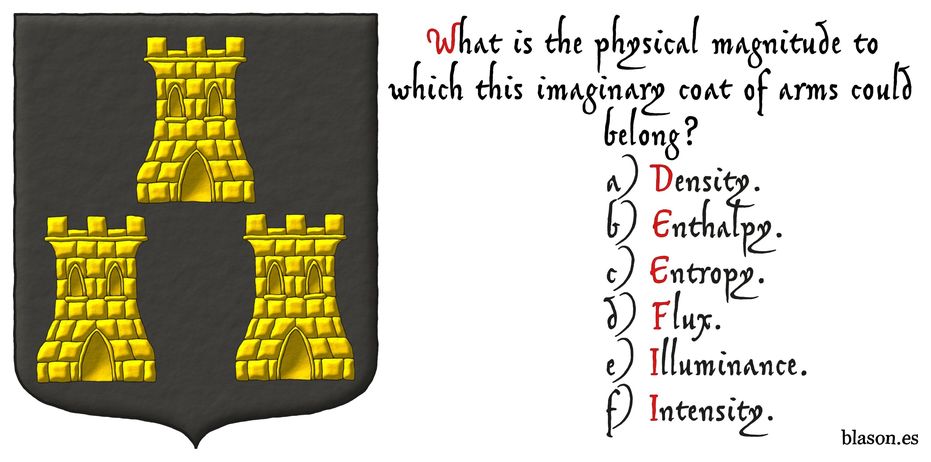Imaginary heraldry


Alborán, Sea of

Party per fess: 1 Sable, three mullets of eight points Argent, 1 and 2; 2 Azure, three anchors Or, 2 and 1.
Escudo cortado: 1o de sable, tres estrellas de plata de ocho puntas, 1 y 2; 2o de azur, tres anclas de oro, 2 y 1.
Coat of arms designed by me, illuminated with lights and shadows, outlined in Sable, with a semi-circular outer contour and with a watercolor finish.
Blazon keywords: Sable, Argent, Azure, Or, Three, Party per fess, Mullet, Disordered, Anchor and Ordered.
Style keywords: Outlined in sable, Illuminated, Semi-circular and Watercolor.
Classification: Imaginary, Created, Boa and Coat of arms.
Imaginary bearer: Alborán, Sea of.


![Ver [Brutus of Britain, banner] en criterios utilizados. Unicornio saltante sobre la divisa, criterio.](../css/Unicornio.Criterio.png)
Brutus of Britain, banner
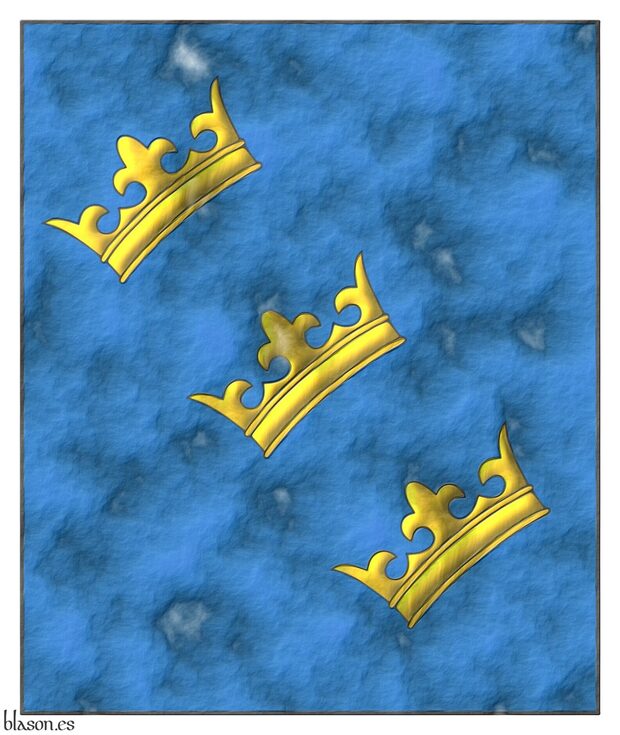
Banner Azure, three crowns in bend, bendwise Or.
Pendón de azur, tres coronas en banda, puestas en banda de oro.
Banner interpreted by me as follows: the field is enameled in plain Azure ink; the three crowns are outlined in Sable and illuminated in Or; and on old parchment.
Banner recreated from [Edward IV of England; 1461; row 13, 1st column].
Blazon keywords: Without divisions.
Style keywords: Rectangular, Illuminated, Outlined in sable and Crystalline.
Classification: Interpreted, Imaginary, Flag, Banner of arms, Kingdom of England and Criterion.
Imaginary bearer: Brutus of Britain.


Categories of heraldry, alternative coat of arms

Alternative coat of arms for the heraldry and its categories.
Quarterly in saltire: 1 Purpure, a crown Or; 2 Vert, a sword point upwards Or; 3 Azure, a crozier Or; 4 Sable, a bezant; an inescutcheon Or charged with a heart Gules; a bordure Argent.
Imaginary coat of arms created by me with the following characteristics: its shape is semicircular; its field is enameled with flat tinctures of Purpure, Vert, Azure, Sable, Or, and Argent; all of its figures are illuminated and enameled in Or, except for the heart, which is Gules; and the whole composition has a metallic finish.
These arms are one of the alternatives created during the process of developing a coat of arms for the categories of heraldry.
Blazon keywords: Quarterly per saltire, Purpure, Vert, Azure, Sable, Or, Argent, Gules, Crown, Sword, Point upwards, Crozier, Bezant and plate, Inescutcheon and Diminished bordure.
Style keywords: Illuminated, Outlined in sable and Watercolor.
Classification: Created, Imaginary and Coat of arms.
Imaginary bearer: Categories of heraldry.


Coat of arms for the Arithmetic
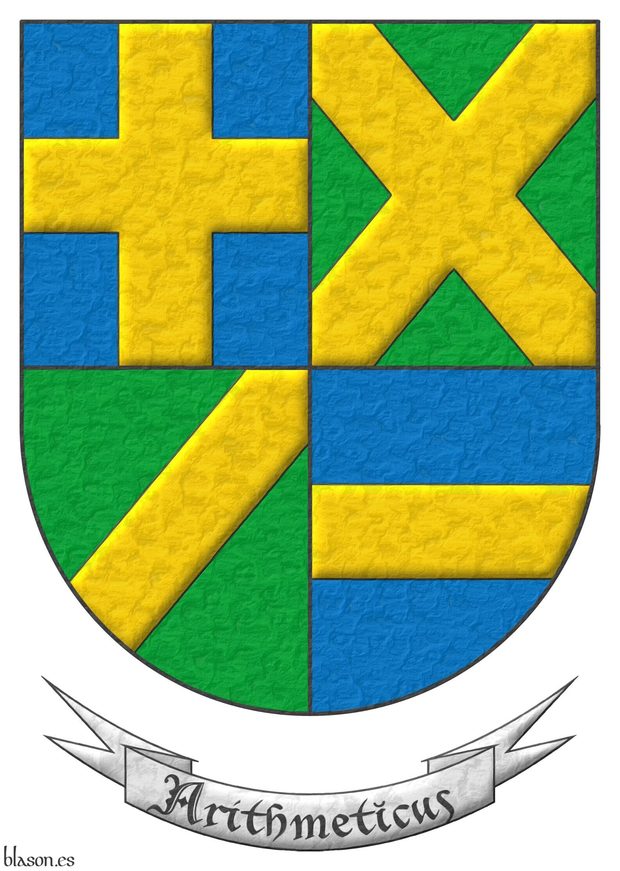
Quarterly: 1 Azure, a cross Or; 2 Vert, a saltire Or; 3 Vert, a bend sinister Or; 4 Azure, a fess Or. Motto: «Arithmeticus».
Escudo cuartelado: 1o de azur, una cruz de oro; 2o de sinople, un sotuer de oro; 3o de sinople, una barra de oro; 4o de azur, una faja de oro. Divisa: «Arithmeticus».
I have made this imaginary coat of arms for the Arithmetic with the following characteristics: a semicircular external shape; its enamelled field with flat color Azure and Vert inks; all the pieces are metal Or, the motto is metal Argent with Sable letters; pieces and motto are illuminated and outlined in Sable; and the whole with a very lightly beaten metal finish.
For the division operation, instead of using the piece bend sinister, 2 bezants Or in pale could have been used. However, since the bezant is a diminished piece, I preferred to use 4 pieces, one for each quarter.
Blazon keywords: Quarterly, Azure, Vert, Or, Cross, Saltire, Bend sinister, Fess and Motto (identification).
Style keywords: Illuminated, Outlined in sable and Soft metal.
Classification: Created, Imaginary and Coat of arms.
Imaginary bearer: Arithmetic.


Cristina, The Knights of
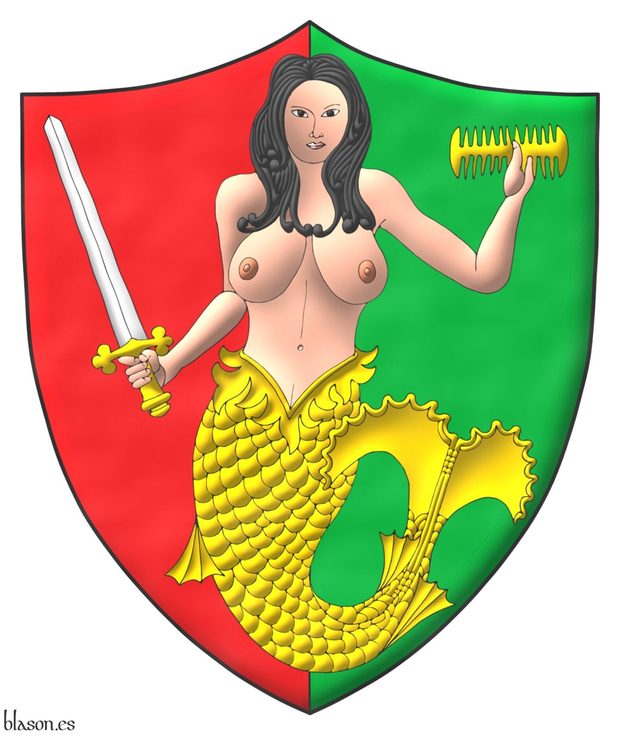
Party per pale Gules and Vert; overall a mermaid proper, holding in her dexter a sword Argent, hilted Or, and in her sinister a comb Or.
Escudo partido de gules y sinople; brochante sobre la partición una sirena al natural, teniendo en su diestra una espada de plata, guarnecida de oro, y en su siniestra un peine de oro.
Coat of arms designed by me, highlighted with lights and shadows, contoured in Sable, and with a watercolor finishing.
Coat of arms of The Knights of Cristina designed under her directions and emblazoned by me.
Blazon keywords: Gules, Vert, Argent, Or, One, Party per pale, Overall, Mermaid, Proper, Grasping, Dexter, Sword, Hilted, Sinister and Comb.
Style keywords: Outlined in sable, Illuminated and Watercolor.
Classification: Imaginary, Created, Boa and Coat of arms.
Imaginary bearer: Cristina, The Knights of.


![Ver [Eight-ball, another version with a terrace in base] en criterios utilizados. Unicornio saltante sobre la divisa, criterio.](../css/Unicornio.Criterio.png)
Eight-ball, another version with a terrace in base

Or, an eight-ball proper on a terrace in base Vert.
Escudo de oro, una bola ocho al natural terrazada de sinople.
Can modern objects appear in a coat of arms?
My rule is: a coat of arms is forever, so any symbol included must be recognizable by future generations. Can you place an iPhone in a coat of arms? No—but not because it’s modern, rather because your grandchildren likely won’t recognize the form of an iPhone; in fact, today’s mobile phones already look quite different from those of a decade ago. Can you include a steam locomotive? Yes, because its form has become anchored in time and in the collective imagination. What about an hourglass, an analog clock, or a black 8-ball from pool? Also yes—their forms are now classics. That is, I believe we can use those symbols that most people already carry in their minds and that are very likely to remain present in the minds of our children and grandchildren. But this is just my humble criterion.
Categories: Criterion, Art, Created, Imaginary, Coat of arms, Semi-circular, Crystalline, Soft metal, Outlined in sable, Illuminated, Without divisions, Or, One, Non-classic artifact, Proper and Terrace in base.
Root: Bola 8.


Ferdinand II, imaginary coat of arms
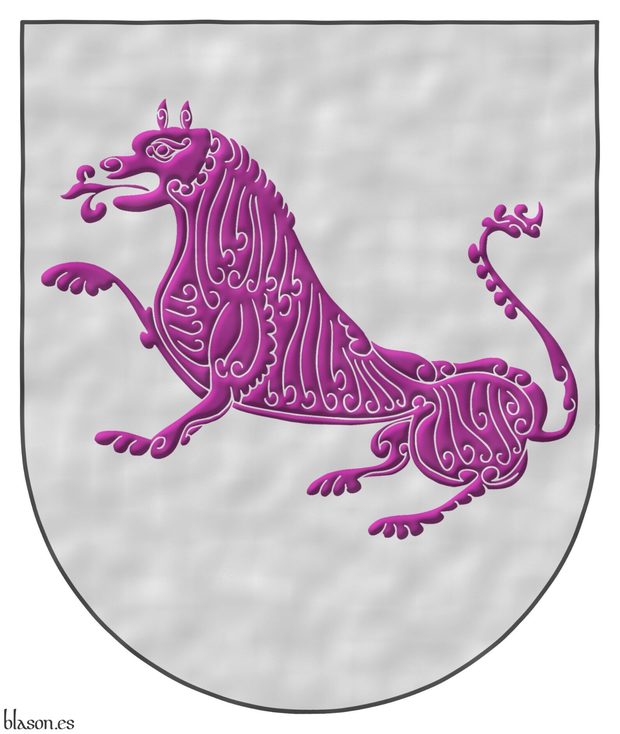
Argent, a lion sejant erect Purpure.
Escudo de plata, un león sentado de púrpura.
Imaginary coat of arms of King Fernando II of León, which I have developed based on his seal and the arms of his successor, with: the shape of the coat of arms is semi-circular; the field enameled in flat argent; the lion enameled in purpure and illuminated; and the whole rendered with a watercolor finish.
For this imaginary coat of arms I have chosen a representation of the lion in a posture similar to that of the great seal appearing in [Fernando II de León; 1167], which is sejant ~ «sentado» in Castilian, although beginning to rise «sejant erect».
It should be noted that we are in a pre-heraldic period where the possible attitudes of the lion were not yet clearly defined, although several of them are already anticipated in the great seals of Fernando II, as can be seen, for example, passant in [Fernando II de León; 1181] and in other attitudes in the photographs of [Martín Fuertes, J. A.; 2002].
Blazon keywords: Without divisions, Argent, Lion, Purpure and Sejant.
Style keywords: Semi-circular, Illuminated, Outlined in the field tincture and Watercolor.
Classification: Interpreted, Imaginary, Coat of arms and Kingdom of León.
Imaginary bearer: Ferdinand II of Leon.


Gryffindor House with a lion
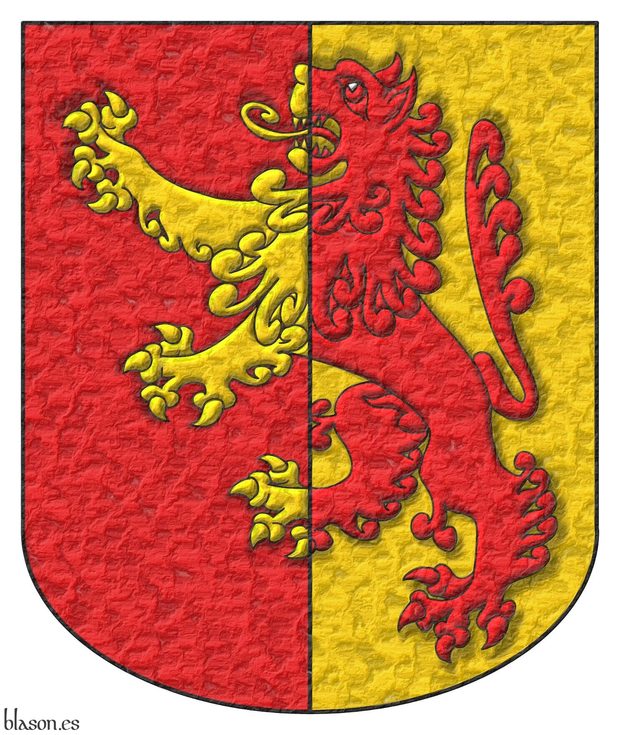
Party per pale Gules and Or, overall a lion rampant counterchanged.
Escudo partido de gules y oro, un león rampante del uno al otro.
Imaginary arms of Gryffindor with the following characteristics: the mouth of the shield is rounded; the shield is party per pale; the field is enameled in flat tinctures of Gules and Or; the lion is illuminated in Or and Gules and outlined in Sable; and it is made with a hammered metal effect.
Blazon keywords: Party per pale, Or, Gules, Lion, Rampant and Counterchanged.
Style keywords: Rounded, Illuminated, Outlined in sable and Freehand.
Classification: Interpreted, Imaginary, Coat of arms and Harry Potter saga.
Imaginary bearer: Gryffindor at Hogwarts.


Holy Trinity
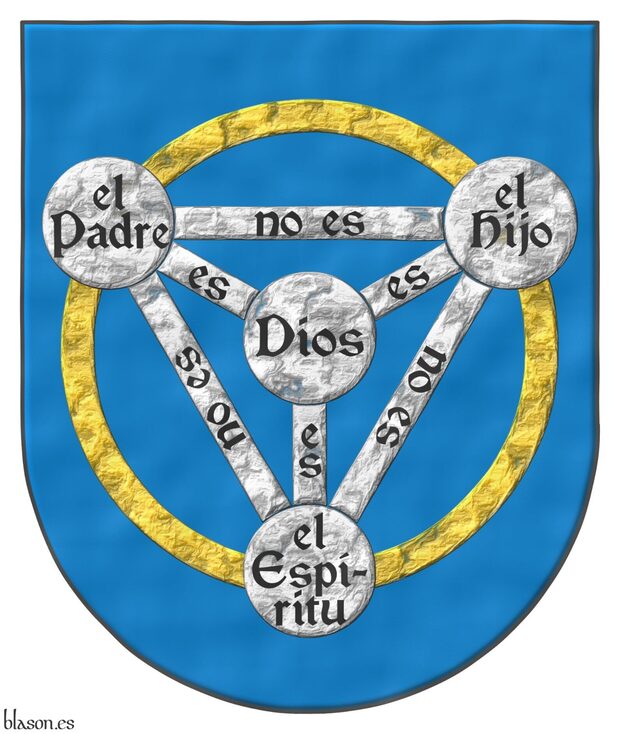
Azure, a pall couped Argent, its three arms charged with «es» Sable, within a triangle reversed Argent, its three arms charged with «no es» Sable, within an annulet Or, all debruised by four plates, three on the vertex of the triangle, in dexter chief, charged with «el Padre» Sable, in sinister chief, charged with «el Hijo» Sable, in base, charged with «el Espítiru» Sable, and one on the fess point, charged with «Dios» Sable.
Escudo de azur, una perla recortada de plata, sus tres brazos cargados con «es» de sable, dentro de un triángulo ranversado de plata, sus tres brazos cargados con «no es» de sable, dentro de un anillo de oro, todo resaltado de cuatro bezantes de plata, tres sobre los vértices del triángulo, en la diestra del jefe, cargado de «el Padre» de sable, en la siniestra del jefe, cargado con «el Hijo» de sable, en la punta, cargado con «el Espítiru» de sable y uno sobre el corazón, cargado con «Dios» de sable.
Imaginary coat of arms that I have interpreted as follows: its base is semicircular (round); its field is illuminated in watercolor Azure; the rest in heavily beaten metal, outlined of the field and illuminated in Argent, except for the annulet which is illuminated in Or; and its letters all in plain Gules ink.
Annulet
The circular crown when it is large and in the middle of the shield [Cadenas y Vicent, V. de; 1975] is called an annulet. [Avilés, J.; 1780a; pages 296 and 297] calls it annulet or small annulet depending on its size, if it is large an annulet and if it is small a small annulet. In English and French heraldry it is called «cyclamor» and hence the expression «cyclamor annulet» can also be found.
This annulet is my aesthetic contribution to this imaginary coat of arms as it is normally not represented with this annulet.
Bordure and Orle
In other interpretations the words «non est» go on a bordure or on an orle, the latter being the case blazoned, for example, [Husenbeth, F. C.; 1882; 2nd appendix] in the following way: «Gules, an orle and pall Argent, conjoined and surmounted of four plates, occupying the dexter and sinister chief and the base and fess points respectively; the first inscribed Pater, the second Filius, and the third Spiritus Sanctus, the centre Deus; the connecting portions of the orle between them having the words non est, and those of the pall est».
Blazon keywords: Without divisions, Azure, Cyclamor, Pall, Closed, Argent, Charged, Bezant and plate, Or, Dexter, Sinister, Chief, Base (lower 1/3) and Heart.
Style keywords: Semi-circular, Illuminated, Outlined in the field tincture, Watercolor and Hard metal.
Classification: Religious, Interpreted, Imaginary and Coat of arms.
Imaginary bearer: Holy Trinity.


Hufflepuff House with 2 badgers
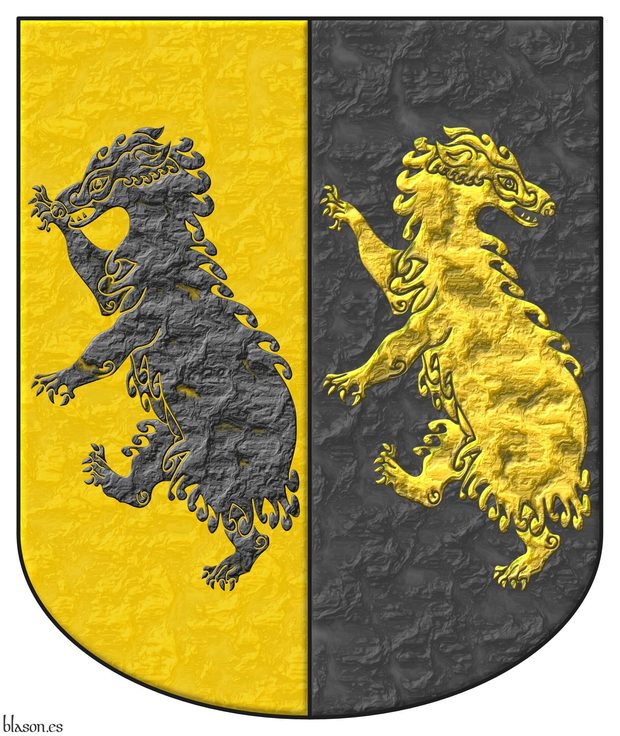
You might belong in Hufflepuff where they are just and loyal. In Hufflepuff they are very patient and unafraid of hard work.
Party per pale: 1 Or, a badger rampant Sable; 2 Sable, a badger rampant, regardant Or.
Escudo partido: 1o de oro, un tejón rampante de sable; 2o de sable, un tejón rampante, contornado de oro.
Imaginary arms of Hufflepuff realized in the following way: the mouth of the coat of arms is rounded; the field is illuminated and has a marble finish; and the badgers, each facing one side, are illuminated, outlined by the field, and finished with a hammered metal effect.
The initial quote, next to the Hufflepuff coat of arms, is taken from [Rowling, J. K.; 1997] and corresponds to «You might belong in Hufflepuff, Where they are just and loyal, Those patient Hufflepuffs are true, And unafraid of toil».
When blazoning the 2nd badger, it must be taken into account that its head is regardant, which is what «is said of animals, or their heads, turned toward the sinister side of the shield» [Avilés, J.; 1725a; page 55] and [Avilés, J.; 1780a; page 61].
Blazon keywords: Party per pale, Or, Sable, Badger, Rampant and Regardant.
Style keywords: Rounded, Illuminated, Outlined in the field tincture, Marmoreal and Metal beaten.
Classification: Interpreted, Imaginary, Coat of arms and Harry Potter saga.
Imaginary bearer: Hufflepuff at Hogwarts.


![Ver [Imaginary heraldry] en criterios utilizados. Unicornio saltante sobre la divisa, criterio.](../css/Unicornio.Criterio.png)
Imaginary heraldry
Within imaginary heraldry, I classify the arms attributed to persons, entities, or things, real, mythical, or imaginary, that could not or cannot possess them, or if they did, their existence is unknown, or due to various circumstances, they neither could nor can assume them.
For example, the coat of arms of Odysseus of Ithaca, legendary hero of Greek mythology, of Brutus of Britain, mythical hero of Troy and founder of Britain who never existed, of Seneca, who historically existed, but could not have had arms as he lived before heraldry, of Hufflepuff at Hogwarts from the Harry Potter books, of the Holy Trinity, of logic, of arithmetic, or of the categories of heraldry.
Categories: Criterion and Imaginary.


Jesus Christ, preparation schema

Schema for an imaginary coat of arms that will have the following characteristics: its base will be semicircular (round); it will contain a closed pearl charged with four bezants; and it will be differenced by a label of three points, which being three is normal, its number will not be specified in the blazon.
Label
The way to elaborate a label can be found in [Avilés, J.; 1780a; page 248] who writes that «it is made of a fillet, which is the ninth part of the latitude of the Chief with three points in the form of a Carpenter's wedge, or of badly formed triangles, which united to it without separation of lines, fall twice as much, as the fillet is wide, the two being placed at its ends, and one in its middle, its ordinary situation being in the middle of the length of the Chief itself, without reaching the edges of the Shield».
Label points
In [Avilés, J.; 1780a; pages 248 and 249] it is said that «the simple Label is always of three points», as is the case at hand, «but having 4, 5, or 6, which is the greatest number found, it is necessary to specify it», although in [Avilés, J.; 1780a; page 114] he seems to consider that the maximum is five as he writes «Points, it is said of three, four and up to five points of the Labels».
Blazon keywords: Without divisions, Pall, Closed, Charged, Bezant and plate, Dexter, Sinister, Chief, Base (lower 1/3), Heart and Label.
Style keywords: Semi-circular.
Classification: Religious, Schema, Interpreted and Imaginary.
Imaginary bearer: Jesus Christ.


King Arthur, ordered crowns
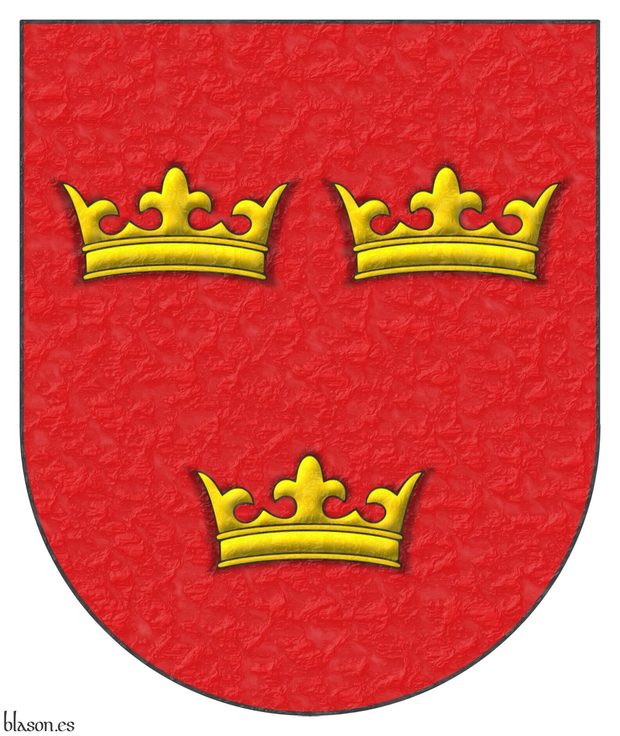
Gules, three crowns Or.
Escudo de gules, tres coronas de oro.
Imaginary coat of arms interpreted in the following manner: the mouth of the shield is semicircular; the field has been enameled with flat color Gules; the crowns are illuminated Or and shaded; and the finish is crystalline.
This imaginary coat of arms proposal for King Arthur can be seen in [Ingeram, H.; 1459; page 30, 2nd shield], sharing the page with Charlemagne, 1st shield, and Godfrey I of Louvain and Duke of Brabant, 3rd shield.
This variant of the imaginary coat of arms of King Arthur is one of the 6 that are illustrated, although more are listed, in the article [Scott-Giles, C. W.; 1965; paragraph 8, figure 2nd], with variants of 10 and up to 13 crowns.
Blazon keywords: Without divisions, Gules, Or, Crown and Ordered.
Style keywords: Illuminated, Shaded, Outlined in sable, Crystalline and Ogee.
Classification: Interpreted, Imaginary, Coat of arms and Kingdom of England.
Imaginary bearer: Arthur of Britain.


Mediterranean, Sea of the

Party per fess: 1 Sable, three mullets of eight points Argent, 1 and 2; 2 Azure, a ship in full sail Or.
Escudo cortado: 1o de sable, tres estrellas de plata de ocho puntas, 1 y 2; 2o de azur, un barco de oro.
Arms devised by me, highlighted with lights and shadows, outlined in Sable, with a semi-circular external shape and with a watercolor finish.
Blazon keywords: Sable, Argent, Azure, Or, Three, Eight, One, Party per fess, Mullet, Disordered, Ship and Full sail.
Style keywords: Outlined in sable, Illuminated, Semi-circular and Watercolor.
Classification: Imaginary, Created, Boa and Coat of arms.
Imaginary bearer: Mediterranean, Sea of the.


Modus ponens, tierced per fess

Mullet, mullet implies crescent, therefore crescent.
Tierced per fess: 1 Vert, a mullet of eight points Or; 2 Gules, a potent fesswise Argent, between in dexter a mullet of eight points, in siniester a crescent Or; 3 Azure, a crescent Or.
Escudo terciado en faja: 1o de sinople, una estrella de ocho puntas de oro; 2o de gules, una potenza puesta en faja de plata, acompañada a la diestra de una estrella de ocho puntas, a la siniestra de un creciente ambos de oro; 3o de azur, un creciente de oro.
Tierced per fess variant of the coat of arms of Logic with: a semicircular (round) base; the field in plain colours Vert, Gules, and Azure; the 5 figures in Or and Argent, outlined in Sable and illuminated; and the whole with a raised-stroke effect.
Blazon keywords: Tierced per fess, Vert, Gules, Azure, Mullet, Crescent, Or, Potent, Argent, Fesswise and Between.
Style keywords: Illuminated, Outlined in sable and Freehand.
Classification: Created, Imaginary and Coat of arms.
Imaginary bearer: Logic.


Odysseus of Ithaca

Party per pale: 1 Vair; 2 Sable, a barn owl Argent, the eyes Sable, beaked and armed Or.
Escudo partido: 1o de veros; 2o de sable, una lechuza de plata, encendida de sable, picada y armada de oro.
Blazon keywords: Party per pale, Argent, Azure, Vair, Sable, Or, Barn owl, The eyes, Beaked and Armed.
Style keywords: Rounded, Illuminated, Outlined in sable and Parchment.
Classification: Created, Imaginary, Coat of arms and Greco-Roman antiquity.
Imaginary bearer: Odysseus of Ithaca.


Sable, three Towers Or, two and one
Sable, three Towers Or, two and one
The classic heraldic layout for three charges on a coat of arms is two in chief and on in base. The layout one in chief and two at base are considered disordered in many heraldic traditions.
The blazon of this coat of arms, «Sable, three Towers Or, two and one», is disordered, and the entropy refers to disorder, and more entropy means more disorder. Then this imaginary coat of arms is full of entropy, and it could belong to the entropy.
Categories: Riddle solution, Imaginary, Sable, Three, Tower, Or, Two, One and Disordered.


Triangulation 2, chaussé, contre-embrassé, embrassé, and chapé
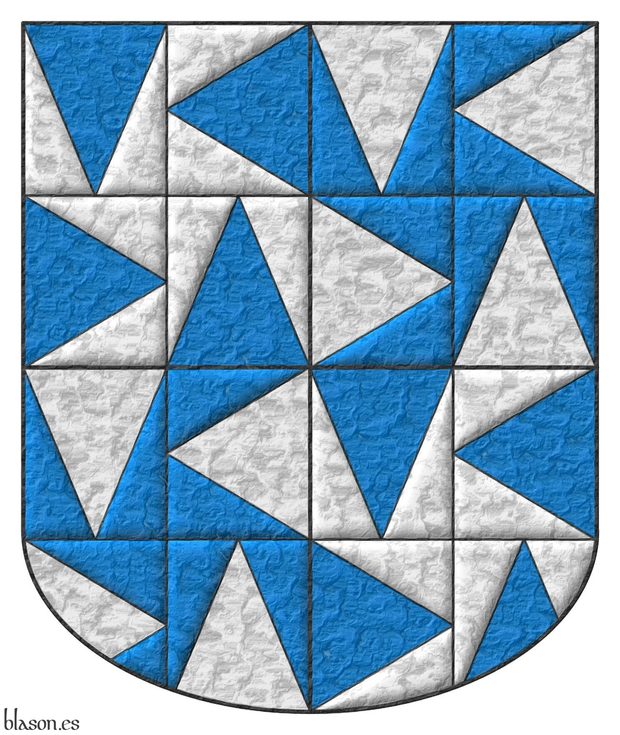
Quarterly of four in four: 1 and 11 Azure, chaussé Argent; 2 and 12 Azure, contre-embrassé Argent; 3 and 9 Argent, chaussé Azure; 4 and 10 Argent, contre-embrassé Azure; 5 and 15 Azure, embrassé Argent; 6 and 16 Azure, chapé Argent; 7 and 13 Argent, embrassé Azure; 8 and 14 Argent, chapé Azure.
Escudo partido de cuatro y cortado de lo mismo: 1o y 11o de azur, calzado de plata; 2o y 12o de azur, contraembrazado de plata; 3o y 9o de plata, calzado de azur; 4o y 10o de plata, contraembrazado de azur; 5o y 15o de azur, embrazado de plata; 6o y 16o de azur, cortinado de plata; 7o y 13o de plata, embrazado de azur; 8o y 14o de plata, cortinado de azur.
Imaginary coat of arms created for aesthetic purposes with: a rounded base; its fields enameled with plain tinctures Argent and Azure; the charges that accompany them, those that form the chapé, chaussé, embrassé, and contre-embrassé, outlined in Sable and illuminated in Argent and Azure; and the whole shield has received a beaten metal finish.
[Avilés, J.; 1725a; pages 47 and 48] tells us about the chaussé that «se entiende cuando el Escudo está dividido en forma de Chevron ranversado», that is, inverted, «de modo, que llegue con su punta a lo bajo de la del Escudo, y las piezas, que le acompañan, hacen la acción de calzar, subiendo de lo bajo a lo alto; de cuya forma toma el nombre, suponiéndole siempre por campo el espacio, que hay entre las dos líneas de dichas piezas» and gives as an example Pomponne in Burgundy whose coat of arms is «de plata, calzado de gules» which is shown in [Avilés, J.; 1725a; ilustración 78].
Blazon keywords: Quarterly, Chapé, Chaussé, Embrassé, Contre-embrassé, Argent and Azure.
Style keywords: Rounded, Illuminated, Outlined in sable and Metal beaten.
Classification: Imaginary.
Imaginary bearer: Triangulation.
-
Language
-
Categories of heraldry
-
Divisions of the field
- Without divisions
- Party per pale
- Party per fess
- Party per bend
- Party per bend sinister
- Tierce
- Tierce sinister
- Tierced per pale
- Tierced per fess
- Tierced per bend
- Tierced pallwise inverted
- Quarterly
- Quarterly per saltire
- Gyronny
- Party per fess, the chief per pale
- Party per pale, the sinister per fess
- Party per fess, the base per pale
- Party per pale, the dexter per fess
- Chapé
- Chaussé
- Embrassé
- Contre-embrassé
- Party per chevron
- Enté
- Enté en point
- Flanched
-
Metals
-
Colours
-
Furs
-
Other tinctures
-
Ordinaries and sub-ordinaries
-
Diminutives of the ordinaries
-
Geometric charges
-
Composite ordinaries
-
Inanimate charges from Nature
Atom, Crescent, Diamond, Emerald, Estoile, Increscent, Lightning flash, Moon, Mount, Mullet, Mullet of four points, Orbital, Plough of Ursa Major, Rainbow, Ray of the sun, River, Sea, Snowflake, Sun, Sun in splendour, Sun of May, Trimount and Water.
-
Vegetal charges from Nature
Acorn, Apple, Apple tree, Ash, Bluebonnet, Camellia, Chrysanthemum, Cinquefoil, Cornflower, Dogwood flower, Double rose, Elm, Fleur de lis, Flower, Gourd, Holm oak, Hop cone, Kapok tree, Laurel, Lily, Linden, Lotus flower, Madonna lily, Oak, Olive tree, Palm tree, Pomegranate, Poplar leaf, Rose, Shamrock, Sunflower, Thistle, Tree, Tulip, Vine and Wheat.
-
Animal charges from Nature
Badger, Bald eagle, Barbel, Barn owl, Bear, Beaver, Beetle, Bighorn sheep, Blackbird, Boar, Brach hound, Bull, Doe, Dog, Dolphin, Dove, Eagle, Elephant, Falcon, Fish, Flame, Fly, Fox, Frog, Goat, Goldfinch, Goose, Heron, Horse, Hummingbird, Jaguar, Lark, Leopard, Lion, Lion passant, Lion rampant guardant, Lioness, Lynx, Male figure, Martlet, Merino ram, Owl, Panther, Parrot, Peacock, Pelican, Pelican in her piety, Puffin, Quetzal, Raven, Roe deer, Rooster, Savage, Seagull, Serpent, She-wolf, Stag, Starling, Talbot, Tyger, Vulture, Warren hound and Wolf.
-
Parts of natural charges
Arm, Beak, Branch, Caboshed, Chest, Claw, Covert, Dorsal fin, Eagle claw, Ermine spot, Escallop, Feather, Foot (palmiped), Foreleg, Forepaw, Hand, Head, Heart, Hoof, Leaf, Neck, Ostrich feather, Palm frond, Paw, Roe deers' attires, Shoulder, Sprig, Stags' attires, Stem, Swallow-tail, Tail, Tail addorsed, Tail fin, Talon, Tooth, Trunk, Trunk (elephant), Two hands clasped, Two wings in vol, Udder, Wheat spike, Wing and Wrist.
-
Artificial charges
Ace of spades, Anchor, Anvil, Arch, Arm vambraced, Armillary sphere, Arrow, Axe, Bell, Bell tower, Beret, Bonfire, Book, Bookmark, Bow, Bridge, Broken, Buckle, Cannon, Cannon dismounted, Cannon port, Canopy roof, Carbuncle, Castle, Celtic Trinity knot, Chain, Chess rooks, Church, Clarion, Clay pot, Closed book, Club, Comb, Compass rose, Conductor's baton, Cord, Covered cup, Crozier, Crucible, Cuffed, Cup, Cyclamor, Dagger, Double vajra, Drum, Ecclesiastical cap, Fanon, Federschwert, Fleam, Four crescents joined millsailwise, Galician granary, Garb, Gauntlet, Geometric solid, Grenade, Halberd, Hammer, Harp, Host, Hourglass, Key, Key ward, Knight, Knot, Lantern, Letter, Line, Loincloth, Menorah, Millrind, Millstone, Millwheel, Monstrance, Mortar, Mullet of six points pierced, Nail, Non-classic artifact, Norman ship, Number, Oar, Oil lamp, Open book, Page, Pair of scales, Parchment, Pestle, Piano, Pilgrim's staff, Plough share, Polish winged hussar, Port, Portcullis, Potent, Quill, Ribbon, Rosette of acanthus leaves, Sabre, Sackbut, Sail, Scroll, Scythe, Sheaf of tobacco, Ship, Skirt, Spear, Spear's head, Stairway, Star of David, Step, Sword, Symbol, Tetrahedron, Torch, Tower, Trident, Trumpet, Turret, Two-handed sword, Wagon-wheel, Water-bouget, Wheel, Winnowing fan and With a turret.
-
Immaterial charges
Angel, Archangel, Basilisk, Dragon, Dragon's head, Garuda, Golden fleece, Griffin, Heart enflamed, Mermaid, Our Lady of Mercy, Ouroboros, Paschal lamb, Pegasus, Phoenix, Sacred Heart of Jesus, Saint George, Sea-griffin, Trinity, Triton, Unicorn, Winged hand and Wyvern.
-
External elements
-
Heraldic creations
-
References
-
Formats
-
Keywords on this page
Watercolor, Proper, Azure, Bezant and plate, Boa, Charged, Closed, Heart, Crown, Party per fess, Created, Crystalline, Criterion, Quarterly, Outlined in sable, Outlined in the field tincture, Disordered, Dexter, Coat of arms, Sword, Mullet, Gules, Illuminated, Imaginary, Interpreted, Chief, Lion, Semi-circular, Metal beaten, Soft metal, Ordered, Or, Party per pale, Pall, Argent, Without divisions, Base (lower 1/3), Purpure, Rampant, Rounded, Kingdom of England, Religious, Sable, Harry Potter saga, Sinister, Vert, Tower, Three and One.

